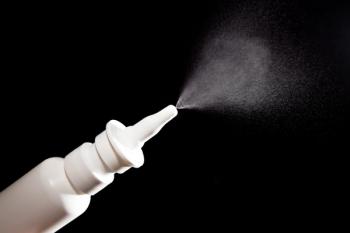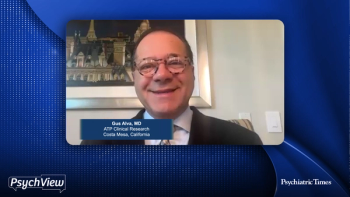
Advising Clinicians on Using Intranasal Esketamine
Lisa Harding, MD, and Angelos Halaris, MD, PhD, APA, ACNP, CINP, give advice to any clinicians considering the use of intranasal esketamine for treatment resistant depression.
Episodes in this series

Lisa Harding, MD: I want to shift gears for a second and ask about getting this cost covered and stuff like that with your patients. Can you provide your perspective on the cost associated with the administration of intranasal esketamine and how you navigate payer reimbursement?
Angelos Halaris, MD, PhD, APA, ACNP, CINP: That’s a very good question. The news is still a little unclear. We’ve had a lot of problems getting insurance companies to fund it. They require a lot of justification and paperwork. However, the company Janssen [Pharmaceuticals] provides assistance through CarePath. I don’t know how independent CarePath is from Janssen, but it doesn’t matter. We’ve used CarePath, and we continue to use them. That’s the first issue we do. Once we obtain the insurance information with patients’ written consent, their data are passed on to CarePath. They’re amazingly efficient in getting an answer to us within 36 to 48 hours about their evaluation. It saves our staff tons of time.
Lisa Harding, MD: Absolutely. We use them as well, and because of their work, sometimes we’ve gotten a co-pay as little as $10 for some of our patients.
Angelos Halaris, MD, PhD, APA, ACNP, CINP: I agree. Yes, $10 co-pay. Sometimes it’s been $20. That’s amazing. But jumping through hoops with insurance companies is still an issue.
Lisa Harding, MD: It probably always will be for us.
Angelos Halaris, MD, PhD, APA, ACNP, CINP: Yes. The other thing that some insurance companies require is evidence by means of rating scales and scores that the treatment is effective, because they’re not going to continue to pay thousands of dollars if the treatment is ineffective. I understand that. What I routinely do is either a MADRS [Montgomery-Asberg Depression Rating Scale] scale at the start, or I prefer the 17-item Hamilton Rating Scale for Depression.
Lisa Harding, MD: Me too. I don’t like math.
Angelos Halaris, MD, PhD, APA, ACNP, CINP: Oh my goodness. Where have you been all these years?
Lisa Harding, MD: I love it. Yes, that’s the 1 I use as well. How often do you do it? I do it at the beginning and then at treatment 8 to prove maintenance going forward.
Angelos Halaris, MD, PhD, APA, ACNP, CINP: Yes, I do it at the beginning, then no later than 4 weeks later after the completion of the first month of treatment, and then no less than monthly intervals thereafter. Once they’re in the maintenance phase and come back for treatment twice a month—I haven’t gone down to once a month yet, but I’m thinking about 3-week intervals down the road—I do it monthly thereafter just to make sure we’re staying on track. It’s a long journey to get there. These are patients who have suffered for decades if not for life.
Lisa Harding, MD: It’s so interesting that you say that. Can I tell you why? I’m smiling because we practice in a really similar way. I’m also hoping to get to once a month just like you. But it’s because you and I are different in that we see a lot of treatment-resistant patients. For us, we’re like that last line of defense. It’s really nice to find a colleague who has good clinical practice.
Angelos Halaris, MD, PhD, APA, ACNP, CINP: We need to hold these kinds of discussions a little more frequently.
Lisa Harding, MD: We really do. I wish we could keep talking, but in wrapping up, I have a question. What advice do you have for other clinicians who are thinking about considering this as a therapeutic option for their patients?
Angelos Halaris, MD, PhD, APA, ACNP, CINP: My advice is that it works as long as you do it right for the right patient in the right constellation. I know we’re short of time, but I want to get back to a question you raised a few minutes ago regarding the dissociation and sedation. They both occur. So far, every patient has had a different dissociative reaction. The sedation is more or less pretty consistent with everybody, but the dissociative reaction is highly individual. It can be fascinating, with visions. I could write a book about those. I have found the dissociative reactions can be vehicles to do interpretation of their life right on site. As they come out of the dissociative reaction, they’re comfortable and calmer. That’s a wonderful setting to intervene psychotherapeutically.
Lisa Harding, MD: Thank you so much. I agree with that. It’s so strange. Because when you mentioned rating scales, I also smiled because I don’t think we have a rating scale yet to measure a dissociative effect. They’re individual. Sometimes I find it dependent on the time of year with how those patterns go. I’ve had patients tell me everything from they were seeing machines to they were floating outside themselves.
Thank you very much for your time. I hope we can do this again.
Angelos Halaris, MD, PhD, APA, ACNP, CINP: Absolutely. This was worth our time, Lisa. Very nice to meet you and compare notes. Let’s keep it going.
Lisa Harding, MD: Yes, let’s do this again. Thank you so much, everyone. Thank you all for watching this Psychiatric Times® Case-Based Psych Perspectives presentation. This has been an excellent discussion, and we hope you found the information to be valuable to your clinical practice.
Angelos Halaris, MD, PhD, APA, ACNP, CINP: Thank you. We really appreciate it. This is a major service to our colleagues and patients.
This transcript has been edited for clarity.
Newsletter
Receive trusted psychiatric news, expert analysis, and clinical insights — subscribe today to support your practice and your patients.















